Eliza Knight's Blog, page 67
September 20, 2011
Historical Fiction Review: Holy Warrior by Angus Donald
 This is the first Angus Donald book I've read, and I found it exhilarating! An adventure in reading, I felt as though I were within the pages, holding my brief, reaching out with my sword to block an assault. I cannot wait to get my hands on the first in this Robin Hood series, OUTLAW and the third, THE KING'S MAN when it releases.
This is the first Angus Donald book I've read, and I found it exhilarating! An adventure in reading, I felt as though I were within the pages, holding my brief, reaching out with my sword to block an assault. I cannot wait to get my hands on the first in this Robin Hood series, OUTLAW and the third, THE KING'S MAN when it releases.ABOUT THE BOOK
After the events ofOutlaw, Robin of Locksley—and his sidekick and narrator, Alan Dale—finds himself in a very different England and a very changed world.
In 1190 A.D. Richard the Lionheart, the new King of England, has launched his epic crusade to seize Jerusalem from the Saracens. Marching with the vast royal army is Britain's most famous, most feared, most ferocious warrior: the Outlaw of Nottingham, the Earl of Locksley—Robin Hood himself. With his band of loyal men at his side, Robin cuts a bloody swath on the brutal journey east. Daring and dangerous, he can outwit and outlast any foe—but the battlefields of the Holy Land are the ultimate proving ground. And within Robin's camp lurks a traitor—a hidden enemy determined to assassinate England's most dangerous rogue.
Richly imagined and furiously paced, featuring a cast of unforgettable characters, Holy Warrior is adventure, history and legend at its finest.
St. Martin's Griffin, August 2011
ISBN: 978-0-312-67837-1, ISBN10: 0-312-67837-1,
Ebook, Hard Cover, Trade Paperback / 400 pages
MY REVIEW
From the opening pages you are pulled into a dramatic, vivid, violent medieval tale, told from the first person point-of-view of Alan Dale, one of Robin Hood's men. All our favorite Robin Hood legendary men are within the tale, but while this is a novel of Robin Hood, it is a tale never told before, and it is this once band of outlaws charging into the fray that was the Holy War, in search of spreading Christianity and saving the Holy Land. Except that Robin Hood was not especially Christian... And deceit, greed, pillaging and fighting take precedence.
Young Alan Dale, sees many things that change him--violance, love, greed, treachery--and through it all, he comes out on top, strong for having learned his lesson and staying true to his honor.
Mr. Donald, did a fabulous job on his research and should be applauded for his authentic historical details. I cringed, I gasped, I exclaimed loudly, I was sad, I was happy. Holy Warrior, is definitely a book that moved me through many emotions! The author truly immersed himself in the tale and it comes through. He knew Robin Hood and his band, he knew about the events of the Holy War and the events of the time period in England. Because of this, Angus Donald was able to pen a brilliant tale that combined actual historical events with legend. I believed this story. I believed it could have taken place. It was real within those pages.
And I must say, I looked forward to what curses Little John was going to come up with next! "God's hairy bollocks!" Hilarious!
Be warned, this is not a tale for the faint of heart. Be prepared and travel on with shield in place, for this brutal tale awaits your reading pleasure. A recommended read for history and Robin Hood fans!
Published on September 20, 2011 09:00
September 19, 2011
Happy Talk Like a Pirate Day!
 Today is Talk Like A Pirate Day! So, I'm re-posting a blog I wrote for Victoria Gray's blog earlier this summer. Enjoy!
Today is Talk Like A Pirate Day! So, I'm re-posting a blog I wrote for Victoria Gray's blog earlier this summer. Enjoy!How to Write a Pirate Hero
This summer saw the release of my very first pirate story, and I had a blast writing it—not to mention the research. Before your mind starts wondering to the bedroom—which yes, those scenes are fun to imagine and write—I'm talking about acting like a pirate! I like all of my stories to be as authentic as possible, and when you are writing a pirate story, there is a certain amount of language and actions that must be incorporated into the story to make it more realistic.
Here are some examples of pirate speak I used to make my story sound more authentic. I have also translated for fun!
"Avast, ye wretches, down ye go, else prepare to feed the fish!"
Attention, prisoners, please exit the ship via the gangplank, or I shall be forced to throw you overboard where you shall be made into a meal for sea creatures.
***
"Might be best to toss her to the sharks."
Perhaps instead of letting her live, it would be best if we killed her and let the sharks eat her.
***"Avast, men! You landlubbers! Back to the ship! We sail within the hour or I shall see you to Davy Jones!"
Attention please, good crew! My wonderful ship workers! Let us board the ship. We will sail within the hour, or I will be forced to sentence you to an eternity at the bottom of the sea with the devilish ghost of the heartless Davy Jones.
***What are some other things you need to make your pirate story authentic?
~A ship of course (which I described on my last post here) or at least the need to get one's ship, like the sexy Jack Sparrow we all know and love… sigh…
~A crew. Every pirate captain needs a crew!
~At least one peg leg, and some eye patches. A pirate story is just not complete without them.
~A pirate flag for your ship, to put fear in the minds of those you intend to dominate.
~A sword fight.
~A hot pirate captain–which you will most definitely find within my novella, A PIRATE'S BOUNTY. Captain Wraith Noir is totally drool worthy! He can capture me anytime! Here is an brief excerpt from the story when Faryn first lays eyes on him:
Faryn chanced a glance above her and was taken aback by what she saw. A man dressed completely in black, from shining leather boots leading to mid-calf, black leather breaches, black linen shirt and cape. His face was darkly tanned, lips covered by a neatly trimmed dark beard on his chin and a mustache. Hard gray eyes stared out at her from beneath raven brows. His hair was not pulled back but left to hang to his shoulders in sleek black locks, and atop that black head was a black cap, various accoutrements attached to it. Beyond beads, feathers and bones, she couldn't make out more of what hung from his cap, nor did she care. She was sure she stood staring directly at the devil.
~ Said pirate captain, must: swagger, be full of confidence, have a wicked smile, kiss sinfully and have a tortured past.
~ And of course, what kind of a pirate story would it be if our sexy dread pirate didn't find a lady to love?
Some great links to visit if you're writing a pirate story are the following:
The Pirate's Realm: http://www.thepiratesrealm.com/
The Pirate King: http://www.thepirateking.com/
Pirate Info: http://www.piratesinfo.com
 A PIRATE'S BOUNTY – Now Available at Ellora's Cave!
A PIRATE'S BOUNTY – Now Available at Ellora's Cave!1764. When Faryn is captured by the mysterious and sensual dread pirate Captain Wraith Noir, who delivers her as a slave to the flesh-hungry court of the pirate queen, she expects her future will be bleak and death imminent. Lucky for Faryn, Wraith doesn't plan for that to be her end, as he wants her for his own.
Duty, desire, passion, revenge and treachery besiege Faryn and Wraith. With the future uncertain, only fate, love and the truth will set them both free.
Reader Advisory: Contains a heroine experiencing the diverse pleasures of a pirate queen's court, including f/f touching and scorching public sex, as well as mentions of traditional pirating endeavors.
To read reviews and an excerpt visit: http://elizaknight.com/APiratesBounty.aspx
Published on September 19, 2011 18:03
September 16, 2011
Romance Writing Contest for Published and Pre-Published Authors
SHORTAGE of ENTRIES in SOME CATEGORIES
DEADLINE EXTENDED to OCTOBER 1, 2011 in the 2011 REVEAL YOUR INNER VIXEN CONTEST
From Maryland Romance Writers
There is still time to enter the Reveal Your Inner Vixen Contest!!!!!
Although we continue to accept submissions in all categories, we are currently low on entries in the following:
Historical
Series Contemporary
Alternative/Paranormal
Young Adult
Erotic
Maryland Romance Writers is proud to announce the 2011 "Reveal Your Inner Vixen" Contest for writers of romantic fiction. Send us your most sizzling scene showcasing sensual tension between your hero and heroine.
Your scene can be a flirtation, a kiss, or a hot and heavy love scene, just as long as the reader can feel that tension!
WHAT DO I ENTER?
Up to 20 pages of any scene that showcases your use of sensual tension, plus an unjudged 1-page set-up (optional).
WHO CAN ENTER?
Anyone! Membership in Maryland Romance Writers or Romance Writers of America is NOT required. The author can be published or not yet published, but the contest entry must be original and uncontracted as of Sept. 1, 2011.
CATEGORIES AND FINAL ROUND JUDGES:
Series Contemporary: (1950-present, 40,000+ words) Gail Chasan, Harlequin/Silhouette; Rhonda Penders, The Wild Rose Press
Single Title: (1950-present, 40,000+ words) Allison Brandau, Penguin/Berkley; Bethany Morgan, Samhain Publishing, Inc;
Historical: (BCE-1950, 40,000+ words) Mary Altman, Ellora's Cave Publishing Inc; and Deb Werksman, Sourcebooks, Inc
Alternative: (Time travel, fantasy, futuristic, paranormal, 40,000+ words) Alicia Condon, Kensington Publishing; Amanda Barnett, The Wild Rose Press
Erotic Romance: (40,000+ words) Raelene Gorlinsky, Ellora's Cave Publishing, Inc; Angela James, Carina Press
Young Adult: (40,000+ words) Krista Marino, Delacorte; Lindsey McGurk, Samhain Publishing, Inc.
HOW DO I ENTER?
Reveal Your Inner Vixen is a fully ELECTRONIC contest. To enter, you will need to visit the Maryland Romance Writers Web site at http://www.marylandromancewriters.com/ and visit the Contest Page to download the Entry Form. The Entry Form will include complete instructions for formatting and submitting your manuscript.
There's also a link to pay for your entry via PayPal, if you wish to do so.
HOW MUCH DOES IT COST?
$20 MRW members
$25 Non-MRW Members--U.S. entries and International entries
WHEN IS THE DEADLINE?
Entries must be time-stamped no later than Oct. 1, 2011.
FOR MORE INFORMATION:
Email the 2011 "Reveal Your Inner Vixen" Contest Coordinator, Jackie Gray, mrwvixen@live.com
Published on September 16, 2011 03:48
September 15, 2011
Fun Facts -- Regency Terminology
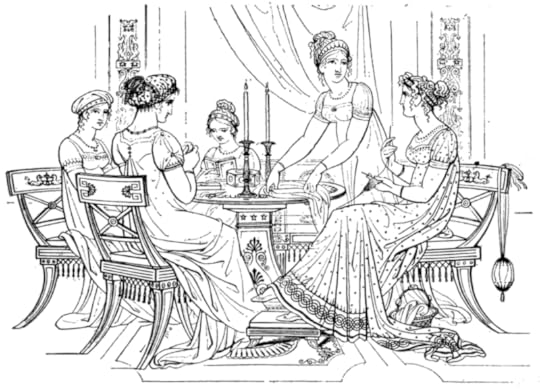 For today's Fun Facts post, I thought I would give you a few Regency terms and their translations... which might be a bit different than you'd expect!
For today's Fun Facts post, I thought I would give you a few Regency terms and their translations... which might be a bit different than you'd expect!~ Abigail -- a lady's maid
~ Black pudding -- sausage made with blood.
~ Bob -- slang for shilling.
~ Climbing boy -- a boy who climbed chimney's to clean them.
~ Expectations -- strong likelihood of inheriting wealth.
~ Gig -- a one-horse carriage.
~ Joseph -- a sort of old-fashioned, long riding coat for women with buttons down the front.
~ Knock up -- wake someone up by banging on their door.
~ Quiz -- a peculiar person or thing.
~ Small clothes -- knee breeches (also referring to men's undies)
Published on September 15, 2011 11:15
September 14, 2011
Historical Video--Terry Jones' Medieval Lives: The Knight
As you know, I've started a weekly post of a historical video I've found on YouTube. Terry Jones' Medieval Lives: The Knight, is part of a series and was originally uploaded by BBCWorldwide. Beware, today's video is about 30 minutes long, so, get yourself a cup of coffee and enjoy!
Here is the description from YouTube: "Terry Jones examines the romantic notion of the Knight in Shining Armour had little interest in rescuing damsels in distress. They were far more interested in the fine arts of killing people, making money and becoming famous. Terry discovers some unsavoury truths."

Here is the description from YouTube: "Terry Jones examines the romantic notion of the Knight in Shining Armour had little interest in rescuing damsels in distress. They were far more interested in the fine arts of killing people, making money and becoming famous. Terry discovers some unsavoury truths."
Published on September 14, 2011 01:00
September 13, 2011
Historical Romance Review: It's Always Been You by Victoria Dahl
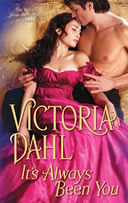 I've been a fan of Victorian-era romance for quite some time, and I've heard many good things about Victoria Dahl's books, so I was eager to read her latest release, It's Always Been You, the second book in her York Family series--and I am eager now to read the first book.
I've been a fan of Victorian-era romance for quite some time, and I've heard many good things about Victoria Dahl's books, so I was eager to read her latest release, It's Always Been You, the second book in her York Family series--and I am eager now to read the first book.ABOUT THE BOOK
ONCE SHE SLIPPED THROUGH HIS FINGERS...
Aidan York has spent ten years mourning the woman he once loved and lost. He's filled the void in the only way he knows—by distracting himself with wild behavior and scandalous trysts. It's a hollow existence, but it dulls the pain. Until the day he encounters a ghost: the woman he thought drowned at sea, alive and as enchanting as ever.
NOW HE'LL KEEP HER IN HIS ARMS...
When Kate Hamilton sees the man she once hoped to spend her life with, she is hit with a storm of memories and longing. But though resisting Aidan's passion proves impossible, Kate must try not to love him all over again. For her seemingly quiet London life shields a dangerous secret, one that will catch up to her the moment she lets herself fall. . .
ISBN: 978-1-4201-0484-4
Pub Date: August 2, 2011
Imprint : Zebra, Paperback
MY REVIEW
This book was fast paced, and started right where it should have, an action filled scene. The author has built a complex, detailed back-story for the characters which are revealed throughout the book (and at some points a little too slow, as I found I was getting confused.) It was a great unfolding, and kept me turning the pages to find out what happened to both Kate and Aidan.
Sensual love scenes that were unique to the characters and I felt moved the story along.
I liked that the majority of the setting was not in London. This makes the book unique and I also liked that the characters were not your typical Lord and Lady. Kate has a dark past. She's running a coffee shop, poor, hard working. Ms. Dahl obviously did her research on coffee. Aidan is also a man of business and has to build his own fortune. His wealth wasn't handed to him on a platter. I was easily engaged in the story, and the author elicited emotions from me for sure. I certainly wanted to strangle the h/h at points, hug them, laugh with them.
The secondary characters were also fun. I enjoyed both Lucy and Mr. Penrose. I also liked the small romance that went on between them.
The dialogue was excellent! Ms. Dahl really can write witty, engaging and entertaining dialogue. Additionally, you actually see these characters grow and change throughout the story.
One teensy weensy nit-picky thing... And normally if used only once I wouldn't bring it up, but it was used several times: Bullocks. In the book it referred to a man's testicles, as in "with my bullocks intact," "located your bullocks" and it was also used as a curse word. The problem is, "bullock" refers to either a castrated male bovine or a young bull. When referring to a male's anatomy or for a curse, it is "bollocks" or "ballocks". I've actually seen this mistake dozens of times. The reason most likely is spellcheck does not recognize "ballocks" or "bollocks" and changes it to "bullocks" and unless you are anal like me, you probably won't even notice. In any case, it doesn't detract from the story, and I really like it when authors use period curses in their writing, it makes it more authentic.
I will definitely read more of Victoria Dahl's work.
Published on September 13, 2011 05:52
September 11, 2011
"Jumps" – The Comfy & Sexy Alternative to Georgian Stays
Welcome back to History Undressed, Lucinda Brant, author of fascinating and sensual Georgian romance and mystery! I'm excited to have you back and today's post is sure to captivate, one of my fav topics--underpinings! Leave a comment for you chance to win an ebook copy of Lucinda's latest release, AUTUMN DUCHESS!
"Jumps" – The Comfy & Sexy Alternative to Georgian Stays by Lucinda Brant
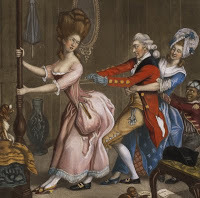 Detail from Tight Lacing, or Fashion before EaseThink Eighteenth Century female undergarments and usually the first article to come to mind is the corset, or stays. Worn over the chemise to cover the breasts and upper torso, stays were made from a variety of materials, cotton to silk, depending on the occasion and most often had a square neckline. The enduring image of a pair of stays is the caricatures of women being laced too tightly; the stays being laced together at the back, and thus requiring an attendant to help dress and undress the wearer. To ensure the requisite conical shape, stays were stiffened with all manner of materials, from buckram (hardened linen or cotton) to whalebone, which also ensured the wearer kept an upright posture. Contrary to popular myth, stays, if worn and laced correctly (it was almost impossible to lace too tightly because eyelets were reinforced with stitching not metal - metal eyelets being a nineteenth century invention) were not uncomfortable and the wearer was able to carry out most everyday duties without hindrance.
Detail from Tight Lacing, or Fashion before EaseThink Eighteenth Century female undergarments and usually the first article to come to mind is the corset, or stays. Worn over the chemise to cover the breasts and upper torso, stays were made from a variety of materials, cotton to silk, depending on the occasion and most often had a square neckline. The enduring image of a pair of stays is the caricatures of women being laced too tightly; the stays being laced together at the back, and thus requiring an attendant to help dress and undress the wearer. To ensure the requisite conical shape, stays were stiffened with all manner of materials, from buckram (hardened linen or cotton) to whalebone, which also ensured the wearer kept an upright posture. Contrary to popular myth, stays, if worn and laced correctly (it was almost impossible to lace too tightly because eyelets were reinforced with stitching not metal - metal eyelets being a nineteenth century invention) were not uncomfortable and the wearer was able to carry out most everyday duties without hindrance.
 Detail of Figured silk jumps with metal closures
Detail of Figured silk jumps with metal closures
 Detail Boucher's La ToiletteA type of stays worn for at-home occasions and often by pregnant and nursing mothers were "jumps". Jumps were an under bodice similar in shape to stays but without the bones. According to Valerie Steel, author of The Corset, the term comes from the French word jupe - short jacket. Made of silk, cotton or linen and often embroidered, jumps fastened over the breasts with ties such as silk ribbons, buttons and, sometimes, metal hooks. Jumps were looser fitting than stays and padded with cotton yet still provided support for the breasts while not being restrictive. While mostly worn at home they were sometimes worn out on social occasions as part of an ensemble.
Detail Boucher's La ToiletteA type of stays worn for at-home occasions and often by pregnant and nursing mothers were "jumps". Jumps were an under bodice similar in shape to stays but without the bones. According to Valerie Steel, author of The Corset, the term comes from the French word jupe - short jacket. Made of silk, cotton or linen and often embroidered, jumps fastened over the breasts with ties such as silk ribbons, buttons and, sometimes, metal hooks. Jumps were looser fitting than stays and padded with cotton yet still provided support for the breasts while not being restrictive. While mostly worn at home they were sometimes worn out on social occasions as part of an ensemble.
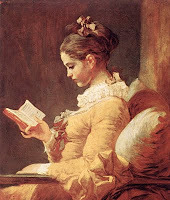 Fragonard's Young Girl Reading Antonia in
AUTUMN DUCHESS
wears jumps every day as a matter of course, and not only for at-home occasions. Then again she can do as she pleases, she is a duchess and thus is a leader not a follower of fashion. But it is not fashion that drives her but comfort. She is a voracious reader and spends a good deal of her time curled up in her favorite wingchair with a good book. Fragonard's Young Girl Reading reveals by her relaxed posture that she too is wearing jumps. Antonia's husband, the all-powerful Duke of Roxton, Monseigneur, preferred her in jumps. And what man wouldn't? Removal of stays required considerable effort and two people, with lacings to unravel at the back, when with a tug of a few silk ribbons jumps gaped open to expose as much cleavage as was warranted; the female wearer rendered bare breasted within seconds. Just this thought sends our hero Jonathon's mind reeling when the widowed Antonia explains to him in a matter-of-fact way the construction of jumps without a thought to the effect her words might have on her rapt male audience of one.
Fragonard's Young Girl Reading Antonia in
AUTUMN DUCHESS
wears jumps every day as a matter of course, and not only for at-home occasions. Then again she can do as she pleases, she is a duchess and thus is a leader not a follower of fashion. But it is not fashion that drives her but comfort. She is a voracious reader and spends a good deal of her time curled up in her favorite wingchair with a good book. Fragonard's Young Girl Reading reveals by her relaxed posture that she too is wearing jumps. Antonia's husband, the all-powerful Duke of Roxton, Monseigneur, preferred her in jumps. And what man wouldn't? Removal of stays required considerable effort and two people, with lacings to unravel at the back, when with a tug of a few silk ribbons jumps gaped open to expose as much cleavage as was warranted; the female wearer rendered bare breasted within seconds. Just this thought sends our hero Jonathon's mind reeling when the widowed Antonia explains to him in a matter-of-fact way the construction of jumps without a thought to the effect her words might have on her rapt male audience of one.
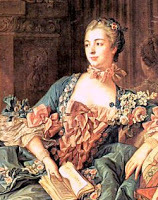 Detail Boucher's painting of Mme de Pompadour and the inspiration for Antonia's jumps fastened with pink ribbons. In 1770, Jacques Bonnaud wrote a treatise on the wearing of whalebone corsets arguing that not only was a woman submitting to a form of torture but that such an undergarment went against the laws of nature because stays prevented a woman from breast feeding her newborn infant. So it is not surprising that pregnant women wore jumps that not only had front lacings but side lacings to allow for the expanding bust and waistline of the mother-to-be and allowed nursing mothers to breast feed, something that could not be accommodated if wearing stays.
Detail Boucher's painting of Mme de Pompadour and the inspiration for Antonia's jumps fastened with pink ribbons. In 1770, Jacques Bonnaud wrote a treatise on the wearing of whalebone corsets arguing that not only was a woman submitting to a form of torture but that such an undergarment went against the laws of nature because stays prevented a woman from breast feeding her newborn infant. So it is not surprising that pregnant women wore jumps that not only had front lacings but side lacings to allow for the expanding bust and waistline of the mother-to-be and allowed nursing mothers to breast feed, something that could not be accommodated if wearing stays.
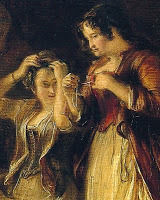 Detail from The Scottish Bedroom by Sir David WilkieAnd it was not until the 1770s when French fashion was leaning toward a simpler style of dress that there was less stiffening in a pair of stays. Women began to eschew whalebone and buckram, preferring quilted linen, and for ease of wear, stays began to be often fastened in the front with strings or ribbons and worn for deshabille, jumps had finally come into their own! You can read more about Antonia, Dowager Duchess of Roxton and her preference for wearing jumps and the effect this sexy undergarment has on her suitor, East India Merchant Jonathon Strang in Lucinda Brant's latest novel,
AUTUMN DUCHESS
, Book 3 of the Roxton Series. Bibliography
Detail from The Scottish Bedroom by Sir David WilkieAnd it was not until the 1770s when French fashion was leaning toward a simpler style of dress that there was less stiffening in a pair of stays. Women began to eschew whalebone and buckram, preferring quilted linen, and for ease of wear, stays began to be often fastened in the front with strings or ribbons and worn for deshabille, jumps had finally come into their own! You can read more about Antonia, Dowager Duchess of Roxton and her preference for wearing jumps and the effect this sexy undergarment has on her suitor, East India Merchant Jonathon Strang in Lucinda Brant's latest novel,
AUTUMN DUCHESS
, Book 3 of the Roxton Series. Bibliography
Glossary of 18th Century Costume Terminology: http://people.csail.mit.edu/sfelshin/...
Figured Silk Jumps, mid-18th Century France http://coraginsburg.com/catalogues/20...
Steele, V. The Corset A Cultural History, 2001, Yale,
Willett, C. and Cunnington, P.A. The History of Underclothes, 1992, Dover publications
Image bibliography
Image 1: Tight Lacing, or Fashion before Ease by Bowles and Carver after John Collet, London, England, ca. 1770–1775. From the collections of the Colonial Williamsburg Foundation.
http://www.history.org/history/teachi...
Image 2: Figured silk jumps with metal closures, French mid 18th Century, www.coraginsburg.com
Images 3, 4 & 5: Art Renewal Centre http://www.artrenewal.org/
Image 6: The Scottish Bedroom by Sir David Wilkie, in Steele, V. The Corset A Cultural History
*~*~*~*
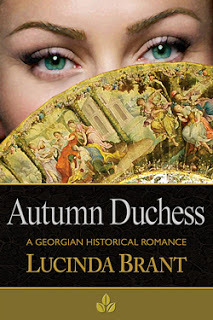 Autumn Duches
s
Autumn Duches
s
Roxton Series Book 3
Sequel to Noble Satyr and Midnight Marriage
A beautiful duchess mourns for her beloved.
A sun-bronzed merchant returns to claim a birthright.
Disparate souls in need of love and renewal.
Paths cross and the journey begins...
Set in Hampshire England in 1777, it is the story of Antonia, the heroine of Noble Satyr, and how she emerges from utter despair after the death of her husband and soul mate the Duke of Roxton to unexpectedly find love again.
Hardcover ISBN (coming soon)
Ebook ISBN 978-0-9808013-5-4
Kindle ASIN B005GLFCX8
To read an excerpt click here: http://lucindabrant.com/autumn-duchess.php

"Jumps" – The Comfy & Sexy Alternative to Georgian Stays by Lucinda Brant
 Detail from Tight Lacing, or Fashion before EaseThink Eighteenth Century female undergarments and usually the first article to come to mind is the corset, or stays. Worn over the chemise to cover the breasts and upper torso, stays were made from a variety of materials, cotton to silk, depending on the occasion and most often had a square neckline. The enduring image of a pair of stays is the caricatures of women being laced too tightly; the stays being laced together at the back, and thus requiring an attendant to help dress and undress the wearer. To ensure the requisite conical shape, stays were stiffened with all manner of materials, from buckram (hardened linen or cotton) to whalebone, which also ensured the wearer kept an upright posture. Contrary to popular myth, stays, if worn and laced correctly (it was almost impossible to lace too tightly because eyelets were reinforced with stitching not metal - metal eyelets being a nineteenth century invention) were not uncomfortable and the wearer was able to carry out most everyday duties without hindrance.
Detail from Tight Lacing, or Fashion before EaseThink Eighteenth Century female undergarments and usually the first article to come to mind is the corset, or stays. Worn over the chemise to cover the breasts and upper torso, stays were made from a variety of materials, cotton to silk, depending on the occasion and most often had a square neckline. The enduring image of a pair of stays is the caricatures of women being laced too tightly; the stays being laced together at the back, and thus requiring an attendant to help dress and undress the wearer. To ensure the requisite conical shape, stays were stiffened with all manner of materials, from buckram (hardened linen or cotton) to whalebone, which also ensured the wearer kept an upright posture. Contrary to popular myth, stays, if worn and laced correctly (it was almost impossible to lace too tightly because eyelets were reinforced with stitching not metal - metal eyelets being a nineteenth century invention) were not uncomfortable and the wearer was able to carry out most everyday duties without hindrance. Detail of Figured silk jumps with metal closures
Detail of Figured silk jumps with metal closures
 Detail Boucher's La ToiletteA type of stays worn for at-home occasions and often by pregnant and nursing mothers were "jumps". Jumps were an under bodice similar in shape to stays but without the bones. According to Valerie Steel, author of The Corset, the term comes from the French word jupe - short jacket. Made of silk, cotton or linen and often embroidered, jumps fastened over the breasts with ties such as silk ribbons, buttons and, sometimes, metal hooks. Jumps were looser fitting than stays and padded with cotton yet still provided support for the breasts while not being restrictive. While mostly worn at home they were sometimes worn out on social occasions as part of an ensemble.
Detail Boucher's La ToiletteA type of stays worn for at-home occasions and often by pregnant and nursing mothers were "jumps". Jumps were an under bodice similar in shape to stays but without the bones. According to Valerie Steel, author of The Corset, the term comes from the French word jupe - short jacket. Made of silk, cotton or linen and often embroidered, jumps fastened over the breasts with ties such as silk ribbons, buttons and, sometimes, metal hooks. Jumps were looser fitting than stays and padded with cotton yet still provided support for the breasts while not being restrictive. While mostly worn at home they were sometimes worn out on social occasions as part of an ensemble.
 Fragonard's Young Girl Reading Antonia in
AUTUMN DUCHESS
wears jumps every day as a matter of course, and not only for at-home occasions. Then again she can do as she pleases, she is a duchess and thus is a leader not a follower of fashion. But it is not fashion that drives her but comfort. She is a voracious reader and spends a good deal of her time curled up in her favorite wingchair with a good book. Fragonard's Young Girl Reading reveals by her relaxed posture that she too is wearing jumps. Antonia's husband, the all-powerful Duke of Roxton, Monseigneur, preferred her in jumps. And what man wouldn't? Removal of stays required considerable effort and two people, with lacings to unravel at the back, when with a tug of a few silk ribbons jumps gaped open to expose as much cleavage as was warranted; the female wearer rendered bare breasted within seconds. Just this thought sends our hero Jonathon's mind reeling when the widowed Antonia explains to him in a matter-of-fact way the construction of jumps without a thought to the effect her words might have on her rapt male audience of one.
Fragonard's Young Girl Reading Antonia in
AUTUMN DUCHESS
wears jumps every day as a matter of course, and not only for at-home occasions. Then again she can do as she pleases, she is a duchess and thus is a leader not a follower of fashion. But it is not fashion that drives her but comfort. She is a voracious reader and spends a good deal of her time curled up in her favorite wingchair with a good book. Fragonard's Young Girl Reading reveals by her relaxed posture that she too is wearing jumps. Antonia's husband, the all-powerful Duke of Roxton, Monseigneur, preferred her in jumps. And what man wouldn't? Removal of stays required considerable effort and two people, with lacings to unravel at the back, when with a tug of a few silk ribbons jumps gaped open to expose as much cleavage as was warranted; the female wearer rendered bare breasted within seconds. Just this thought sends our hero Jonathon's mind reeling when the widowed Antonia explains to him in a matter-of-fact way the construction of jumps without a thought to the effect her words might have on her rapt male audience of one.
 Detail Boucher's painting of Mme de Pompadour and the inspiration for Antonia's jumps fastened with pink ribbons. In 1770, Jacques Bonnaud wrote a treatise on the wearing of whalebone corsets arguing that not only was a woman submitting to a form of torture but that such an undergarment went against the laws of nature because stays prevented a woman from breast feeding her newborn infant. So it is not surprising that pregnant women wore jumps that not only had front lacings but side lacings to allow for the expanding bust and waistline of the mother-to-be and allowed nursing mothers to breast feed, something that could not be accommodated if wearing stays.
Detail Boucher's painting of Mme de Pompadour and the inspiration for Antonia's jumps fastened with pink ribbons. In 1770, Jacques Bonnaud wrote a treatise on the wearing of whalebone corsets arguing that not only was a woman submitting to a form of torture but that such an undergarment went against the laws of nature because stays prevented a woman from breast feeding her newborn infant. So it is not surprising that pregnant women wore jumps that not only had front lacings but side lacings to allow for the expanding bust and waistline of the mother-to-be and allowed nursing mothers to breast feed, something that could not be accommodated if wearing stays.  Detail from The Scottish Bedroom by Sir David WilkieAnd it was not until the 1770s when French fashion was leaning toward a simpler style of dress that there was less stiffening in a pair of stays. Women began to eschew whalebone and buckram, preferring quilted linen, and for ease of wear, stays began to be often fastened in the front with strings or ribbons and worn for deshabille, jumps had finally come into their own! You can read more about Antonia, Dowager Duchess of Roxton and her preference for wearing jumps and the effect this sexy undergarment has on her suitor, East India Merchant Jonathon Strang in Lucinda Brant's latest novel,
AUTUMN DUCHESS
, Book 3 of the Roxton Series. Bibliography
Detail from The Scottish Bedroom by Sir David WilkieAnd it was not until the 1770s when French fashion was leaning toward a simpler style of dress that there was less stiffening in a pair of stays. Women began to eschew whalebone and buckram, preferring quilted linen, and for ease of wear, stays began to be often fastened in the front with strings or ribbons and worn for deshabille, jumps had finally come into their own! You can read more about Antonia, Dowager Duchess of Roxton and her preference for wearing jumps and the effect this sexy undergarment has on her suitor, East India Merchant Jonathon Strang in Lucinda Brant's latest novel,
AUTUMN DUCHESS
, Book 3 of the Roxton Series. BibliographyGlossary of 18th Century Costume Terminology: http://people.csail.mit.edu/sfelshin/...
Figured Silk Jumps, mid-18th Century France http://coraginsburg.com/catalogues/20...
Steele, V. The Corset A Cultural History, 2001, Yale,
Willett, C. and Cunnington, P.A. The History of Underclothes, 1992, Dover publications
Image bibliography
Image 1: Tight Lacing, or Fashion before Ease by Bowles and Carver after John Collet, London, England, ca. 1770–1775. From the collections of the Colonial Williamsburg Foundation.
http://www.history.org/history/teachi...
Image 2: Figured silk jumps with metal closures, French mid 18th Century, www.coraginsburg.com
Images 3, 4 & 5: Art Renewal Centre http://www.artrenewal.org/
Image 6: The Scottish Bedroom by Sir David Wilkie, in Steele, V. The Corset A Cultural History
*~*~*~*
 Autumn Duches
s
Autumn Duches
s
Roxton Series Book 3
Sequel to Noble Satyr and Midnight Marriage
A beautiful duchess mourns for her beloved.
A sun-bronzed merchant returns to claim a birthright.
Disparate souls in need of love and renewal.
Paths cross and the journey begins...
Set in Hampshire England in 1777, it is the story of Antonia, the heroine of Noble Satyr, and how she emerges from utter despair after the death of her husband and soul mate the Duke of Roxton to unexpectedly find love again.
Hardcover ISBN (coming soon)
Ebook ISBN 978-0-9808013-5-4
Kindle ASIN B005GLFCX8
To read an excerpt click here: http://lucindabrant.com/autumn-duchess.php
Published on September 11, 2011 21:00
September 9, 2011
Elizabethan Fun Facts
Starting now! History Undressed will have a weekly post of fun historical facts. Enjoy!
Elizabethan Fun Facts
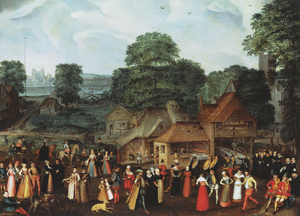
Elizabeth, while Queen of England, rarely mentioned her mother. In fact she did not even attempt to have her birth legitimized as her sister, Queen Mary I had done before her. (Her father, Henry VIII, while he did put her in line for the succession had also claimed she was a bastard, as did her brother, King Edward VI after her.) With her reign tenuous in the beginning, and threats and plots throughout, bringing light to the topic of her birth would have only made her hold on her reign weaker. Many did not even believe she was Henry VIII's true daughter, despite how similar her appearance and bearing was to his.Elizabeth I, imprisoned many of her ladies when they dared to marry without her approval.Suspicion, to this day, surrounds Elizabeth I and her role in the death of her long time love, Robert Dudley's wife, Amy Robsart.Elizabeth's Secretaries of State, Cecil and Walsingham, developed an intelligence agency and ring of spies that spanned all of Europe and more.Elizabeth had forty pairs of velvet shoes until, in 1575, she decided to switch to Spanish leather. Don't panic! She didn't get rid of her shoes, simply had them refurbished.Female characters in plays were played by men--not women.Shakespeare became a popular playwright during the Elizabethan era, but in fact, it was very late into Elizabeth's reign. He was not even born until she'd been Queen for several years. His first play was published and acted in the 1590's. Elizabeth did see at least one or two of his plays. Many vicious rumors abound that Elizabeth is Shakespeare's mother, but these are just rumors.People drank beer at breakfast.Of every 100 babies born alive--not stillbirths--about 70% survived to their first birthday. Less than 50% would make it to the age of 5.Farting and peeing were to be done in private. (If you farted in public, you were supposed to try and cough to cover the sound). Belching at the table was totally acceptable. But it you had to blow your nose or spit you had better turn away.
Elizabethan Fun Facts

Elizabeth, while Queen of England, rarely mentioned her mother. In fact she did not even attempt to have her birth legitimized as her sister, Queen Mary I had done before her. (Her father, Henry VIII, while he did put her in line for the succession had also claimed she was a bastard, as did her brother, King Edward VI after her.) With her reign tenuous in the beginning, and threats and plots throughout, bringing light to the topic of her birth would have only made her hold on her reign weaker. Many did not even believe she was Henry VIII's true daughter, despite how similar her appearance and bearing was to his.Elizabeth I, imprisoned many of her ladies when they dared to marry without her approval.Suspicion, to this day, surrounds Elizabeth I and her role in the death of her long time love, Robert Dudley's wife, Amy Robsart.Elizabeth's Secretaries of State, Cecil and Walsingham, developed an intelligence agency and ring of spies that spanned all of Europe and more.Elizabeth had forty pairs of velvet shoes until, in 1575, she decided to switch to Spanish leather. Don't panic! She didn't get rid of her shoes, simply had them refurbished.Female characters in plays were played by men--not women.Shakespeare became a popular playwright during the Elizabethan era, but in fact, it was very late into Elizabeth's reign. He was not even born until she'd been Queen for several years. His first play was published and acted in the 1590's. Elizabeth did see at least one or two of his plays. Many vicious rumors abound that Elizabeth is Shakespeare's mother, but these are just rumors.People drank beer at breakfast.Of every 100 babies born alive--not stillbirths--about 70% survived to their first birthday. Less than 50% would make it to the age of 5.Farting and peeing were to be done in private. (If you farted in public, you were supposed to try and cough to cover the sound). Belching at the table was totally acceptable. But it you had to blow your nose or spit you had better turn away.
Published on September 09, 2011 03:00
September 8, 2011
On This Day in History...
Today is September 8, 2011...
On this day in history...
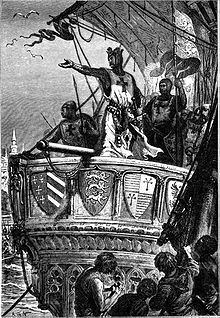 ~Richard I of England was born. He went on to be called Richard the Lionheart, and was brother to Prince John, the two of them being forever legendized in tales of Robin Hood. Richard was a Holy Crusader, leading his men in the fight for the Holy Land, which is why his brother Prince John was left in charge of England in his absence.
~Richard I of England was born. He went on to be called Richard the Lionheart, and was brother to Prince John, the two of them being forever legendized in tales of Robin Hood. Richard was a Holy Crusader, leading his men in the fight for the Holy Land, which is why his brother Prince John was left in charge of England in his absence.
I am reading a REALLY good book right now, called HOLY WARRIOR: A Novel of Robin Hood, by Angus Donald. Look for my review soon, because this book rocks!
On this day in history...
 ~Richard I of England was born. He went on to be called Richard the Lionheart, and was brother to Prince John, the two of them being forever legendized in tales of Robin Hood. Richard was a Holy Crusader, leading his men in the fight for the Holy Land, which is why his brother Prince John was left in charge of England in his absence.
~Richard I of England was born. He went on to be called Richard the Lionheart, and was brother to Prince John, the two of them being forever legendized in tales of Robin Hood. Richard was a Holy Crusader, leading his men in the fight for the Holy Land, which is why his brother Prince John was left in charge of England in his absence. I am reading a REALLY good book right now, called HOLY WARRIOR: A Novel of Robin Hood, by Angus Donald. Look for my review soon, because this book rocks!
Published on September 08, 2011 13:27
A Bit of History on Drawers (See the drawers I made!)
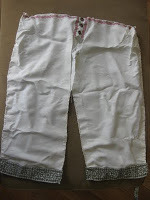 Front of a pair of drawers I made. I love this history of underwear! I have so much fun with it :) Today, I wanted to give you just a tidbit on women's drawers.
Front of a pair of drawers I made. I love this history of underwear! I have so much fun with it :) Today, I wanted to give you just a tidbit on women's drawers.
Drawers came about in the late 18th century for females, however they weren't a commonality until around 1830 when women began to wear drawers/pantaloons/pantalettes almost all the time.
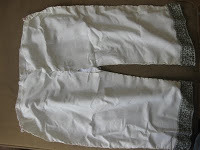 Back of the drawers.Drawers were calf to ankle or knee length, made mostly of linen or silk. They were however used more widely by the upper class than the lower class. So ladies…we've technically only been wearing some form of underwear for 181 years to cover our lady parts down under…not that long… and if our ancestors weren't nobles—which mine were Irish dairy farmers… it may have been that women in your family were only wearing underwear for maybe a century or so.
Back of the drawers.Drawers were calf to ankle or knee length, made mostly of linen or silk. They were however used more widely by the upper class than the lower class. So ladies…we've technically only been wearing some form of underwear for 181 years to cover our lady parts down under…not that long… and if our ancestors weren't nobles—which mine were Irish dairy farmers… it may have been that women in your family were only wearing underwear for maybe a century or so.
There is a difference between drawers, pantaloons and pantalettes. Drawers were shorter. Depending on your social status/wealth, the craftsmanship, fabric and frills would be completely different. Most drawers were crotchless. Why you ask? Have you ever helped a woman lift her wedding gown and shimmy down her panties to pee? It is a TASK! If only the bride would have gone commando or worn crotchless undies. Ah-ha! So, it made certain tasks much easier, you see? I'm sure their male counterparts were also pleased :)
 Shows the "crotchless" section of the drawers.Pantaloons and pantalettes often had pretty lace and embroidery along the bottoms—much like on the sample drawers I made, and were meant to be seen when a woman lifted her skirts, to say, walk over a puddle or up some stairs. Pantalettes, were not only crotchless, they were in fact two separate pieces that covered the legs and tied around the waist. Pantaloons, were more like an extended version of the drawers—coming down to the ankles.
Shows the "crotchless" section of the drawers.Pantaloons and pantalettes often had pretty lace and embroidery along the bottoms—much like on the sample drawers I made, and were meant to be seen when a woman lifted her skirts, to say, walk over a puddle or up some stairs. Pantalettes, were not only crotchless, they were in fact two separate pieces that covered the legs and tied around the waist. Pantaloons, were more like an extended version of the drawers—coming down to the ankles.
Hope you enjoyed this short lesson!
Cheers,
Eliza

 Front of a pair of drawers I made. I love this history of underwear! I have so much fun with it :) Today, I wanted to give you just a tidbit on women's drawers.
Front of a pair of drawers I made. I love this history of underwear! I have so much fun with it :) Today, I wanted to give you just a tidbit on women's drawers.Drawers came about in the late 18th century for females, however they weren't a commonality until around 1830 when women began to wear drawers/pantaloons/pantalettes almost all the time.
 Back of the drawers.Drawers were calf to ankle or knee length, made mostly of linen or silk. They were however used more widely by the upper class than the lower class. So ladies…we've technically only been wearing some form of underwear for 181 years to cover our lady parts down under…not that long… and if our ancestors weren't nobles—which mine were Irish dairy farmers… it may have been that women in your family were only wearing underwear for maybe a century or so.
Back of the drawers.Drawers were calf to ankle or knee length, made mostly of linen or silk. They were however used more widely by the upper class than the lower class. So ladies…we've technically only been wearing some form of underwear for 181 years to cover our lady parts down under…not that long… and if our ancestors weren't nobles—which mine were Irish dairy farmers… it may have been that women in your family were only wearing underwear for maybe a century or so.There is a difference between drawers, pantaloons and pantalettes. Drawers were shorter. Depending on your social status/wealth, the craftsmanship, fabric and frills would be completely different. Most drawers were crotchless. Why you ask? Have you ever helped a woman lift her wedding gown and shimmy down her panties to pee? It is a TASK! If only the bride would have gone commando or worn crotchless undies. Ah-ha! So, it made certain tasks much easier, you see? I'm sure their male counterparts were also pleased :)
 Shows the "crotchless" section of the drawers.Pantaloons and pantalettes often had pretty lace and embroidery along the bottoms—much like on the sample drawers I made, and were meant to be seen when a woman lifted her skirts, to say, walk over a puddle or up some stairs. Pantalettes, were not only crotchless, they were in fact two separate pieces that covered the legs and tied around the waist. Pantaloons, were more like an extended version of the drawers—coming down to the ankles.
Shows the "crotchless" section of the drawers.Pantaloons and pantalettes often had pretty lace and embroidery along the bottoms—much like on the sample drawers I made, and were meant to be seen when a woman lifted her skirts, to say, walk over a puddle or up some stairs. Pantalettes, were not only crotchless, they were in fact two separate pieces that covered the legs and tied around the waist. Pantaloons, were more like an extended version of the drawers—coming down to the ankles.Hope you enjoyed this short lesson!
Cheers,
Eliza
Published on September 08, 2011 05:17



